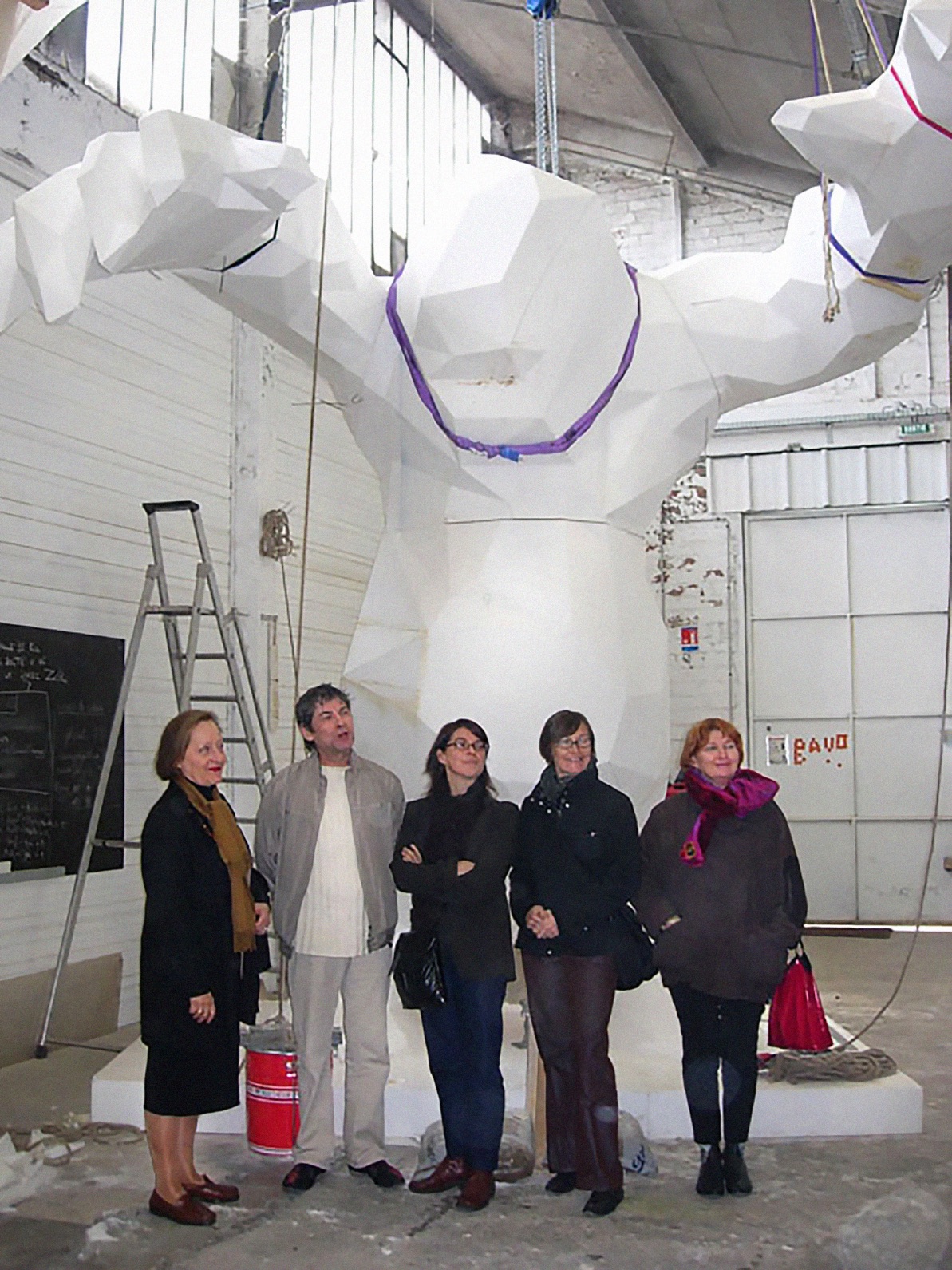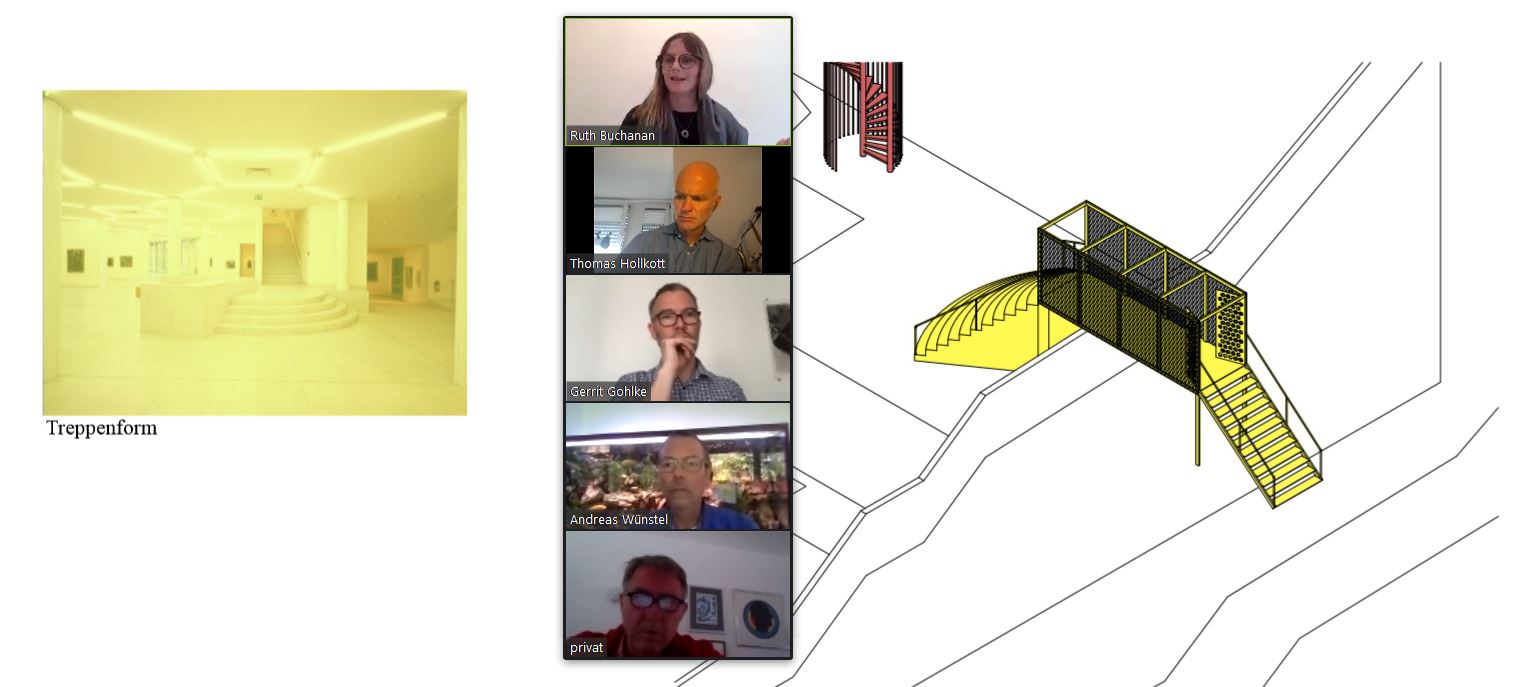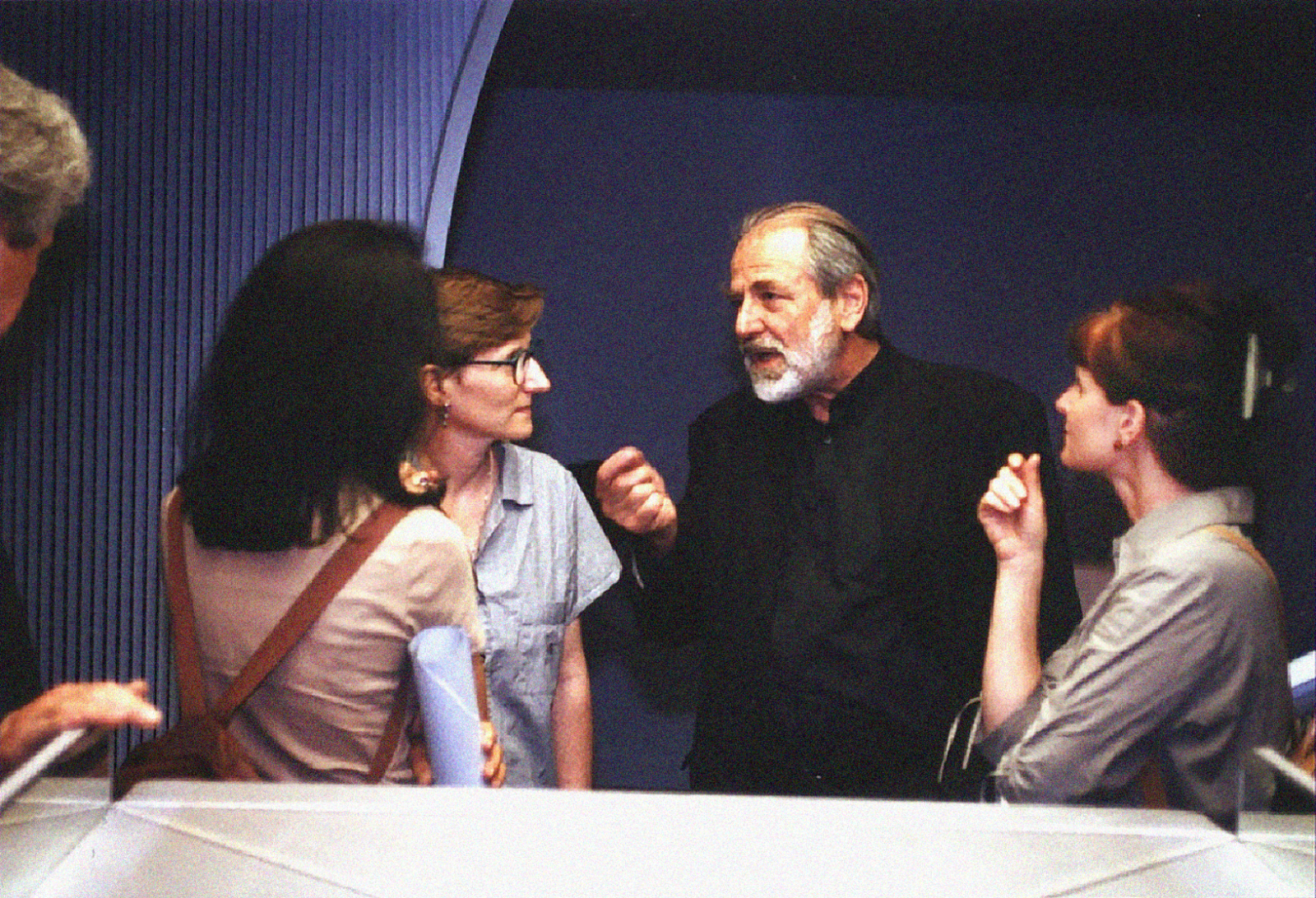An Informal Conversation
Bruno Latour/Joseph Leo Koerner
The philosopher and long-time theoretical companion of the New Patrons Bruno Latour and art historian Joseph Leo Koerner illuminate in their conversation the history of commissioned art up to its most current forms, with a special focus on citizens' commissions.
The conversation, which was originally recorded for the publication Faire art comme on fait société (les presses du réel), is available in German for the first time. Published in 2013, the reader covers a broad field of theoretical perspectives on the programme of the New Patrons. The adapted and supplemented English-language edition Reclaiming Art. Reshaping Democracy (les presses du réel) was released in 2017.
Bruno Latour (*1947) is a French sociologist and philosopher whose focus is on the history of science. He has taught at various international universities, most recently at Science Po Paris, and is one of the founders of actor-network theory. Latour is an influential thinker of our time. His writings, translated into numerous languages, have become foundational works in various theoretical debates, such as the discourse on climate change. At the ZKM Karlsruhe, he worked as a curator on iconic exhibition projects. Latour has been an important supporter of the New Patrons from the beginning.
Joseph Leo Koerner (*1958) is an American art historian and filmmaker. He is a professor of art and architectural history and Senior Fellow, Society of Fellows, at Harvard University. After studying philosophy and English and German literature, Koerner switched to art history through his work on Caspar David Friedrich and shifted his research focus to European art from the Renaissance to the present. He has collaborated with Bruno Latour on a number of exhibitions at the ZKM Karlsruhe.
Bruno Latour:
So, let’s talk about the New Patrons.
It’s been going on for more than twenty years now. The Fondation de France is the historical funder of it. It is a very original enterprise which aims at re-mediating between the offer and the demand of art. It has created hundreds and hundreds of works of art and mobilized quite interesting artists. It’s basically arriving after such an “autonomization” of artists that the connection with the people, whose demand for art could be activated, is difficult. In fact, the people don’t find a possible connection because the artist is too autonomous and modern art or contemporary art despair too many people. They think it’s not for them and yet there is a demand for art.
So, François Hers, a photographer originally, has invented this procedure. And it’s really his work of art, his procedure: To re-establish the connection between a demand for art and an offer of art, by having paid mediators who alert themselves to the demand of people who are not necessarily poor people. It can be the association of Psychoanalysts from Metz or the butchers from the middle of Paris or the physicians from a big hospital in Paris... The very interesting part is that the New Patrons insert state-of-the- art, cutting edge artists, so it’s not socio-Q as they say in France, which stands for socio-cultural 1.
The financing of art by the state is very common in France, but without demand. So, when it is produced, it lets the autonomous artist do whatever he wants, and we pay for that even though there is no interest.
So, this is the framework, and what I’m interested in having your view on is basically: What are the new trends in the history of patronage? Because it is in fact a modern way of doing patronage.
And the other interesting thing is: what other cases would you have, of works of art which have actually been modified, in their detail, by the input of people, even uninfluential people?
Joseph Leo Koerner:
First, I don’t think there’s a long history of this relationship because history actually keeps on replaying itself, on reversing itself in different periods, and different circumstances.
So, the long history used to be clearly that, in the era of the medieval cathedrals, there was created a world in which not only artists, sculptors in relationship to architects, in relationship to builders, not only were they commissioned by the city to build the gothic cathedral, but they weren’t even individuals. They were an entire community which would live organically with the community over many generations.
BL:
Yes, you mentioned that when we were visiting Sienna...
JLK:
Yes. The Hutte, the sort of Bauhutte...This is the old story. After, it starts to fall apart during the period of war, particularly the Hundred Years’ War, with the completion of the cathedrals and the wars between France and England.
A fragmentation occurs and a new kind of patronage emerges from the main forms of art which is courtly patronage, with its own very complicated mixture of commission, exchange, gift exchange, which is very interesting.
And then the courtly world, which is more a gift culture, is replaced by the beginnings of a bourgeois patronage where artists live in 206 towns. They are usually controlled by guild regulations and they usually work on commission until—and that’s the final phase— until there emerges in certain towns where there is a lot of talents, a kind of overproduction of art and it allows fairs and a place to sell pictures.
BL:
Where are we now in dates, approximately?
JLK:
So, the medieval Bauhutte ends at the end of the 13th century. In the 14th century, with the plague and the Hundred Years’ War, you have the height of the courtly art.
In the 15th century, you have the beginnings of bourgeois patronage, in Northern Europe in particular, but also in Italy with the guild structures.
And then very soon, you have a market for art pictures and the earliest example, actually, is Antwerp, where you could buy pictures in an open market as early as the 15th century. That is known. And then it develops.
BL:
Which means an individual painting is no longer a commission. They are produced by something which begins to be the interest of the artist, with the market in view?
JLK:
Exactly, and with the fully developed form of the art market, and of the art trade, you have specializations. Different artists doing different kinds of things, you also have serial production. You have the same painting produced 30 or 40 times and you have new forms of distribution. People would pack piles of pictures into a boat and ship them to Italy. We have examples of 120 landscapes being shipped from Antwerp to Italy.
And then comes printing! With printing, a whole new set of problems emerge: You need more money to have the printing press and you have a professionalized whole printing trade by the end of the 16th century. Dürer comes in between the two models.
He is a person who very clearly and explicitly shifts from a world of commission to a world of making art for an open market by way of becoming a printmaker. So, that’s the usual story, but there are clearly...
BL:
...counter currents?
JLK:
Yes. The most important one is that of the courtly models. If one wanted to do case studies, one could consult Martin Warnke’s great book called The Court Artist.
Court artists are people who, on the one hand, are under the patronage of one person but, on the other hand, they’re able to be bought or sold and sometimes personally migrate from one patron to another.
Sometimes artists are lent by a duke or a prince and there is the beginning of an autonomous production in the court artists because artists at court are typically not paid. They are paid in gratuity, and therefore they make works that are gifts to their patrons.
BL:
That’s why you were saying gifts...
JLK:
Yes! So, you have examples of artists who make gifts for a patron, not to get paid but to be patronized again, and those works are not necessarily autonomous, but they have the seeds of a kind of autonomy in them because they have to do with the free agency of the artists in choosing the subject matter and they are paid also by the prince, by a counter gift, which is kind of optional.
So, the world of the court artist is in some ways avant-garde in relationship to patronage.
That’s one of Warnke’s points. You have people being able to imagine what the prince might want on one hand and then you have princes paying artists.
BL:
In exchange?
JLK:
No, without knowing what it’s going to be!
So, we know for example that Philip the Fair gives money to Hieronymus Bosch to paint him a last judgment, but doesn’t tell him how big it should be or what it should contain because he knows that it’s going to come back as a very beautiful thing.
BL:
So, there is no commission here, exactly? There is no detail. No influence on what is painted.
JLK:
Right, he knows that if you leave the artist a certain degree of freedom, it’s going to come back as something very interesting.
BL:
But, do we have cases where the prince gives the money and other parties, critics, colleagues, intervene into the way the painting is going to evolve?
JLK:
Well, that’s different. In the case of courtly art, you usually have the situation where artists are hardly mentioned, they are servants and no historical reconstruction has ever been able to find out who they are.
The most extreme of this is the case of the gold objects, which the Burgundy Princes liked above all, and they were melted down when the duke needed money, and the duke seemed to not have cared at all about it, but the people who made them would go off into a cloister in despair.
But then, there were also greater artists like Jan Van Eyck who seemed to have an enormous prestige in which the ruler, the Duke of Burgundy, for example, always paid him extra money, more than anyone else in his court, basically, because he knew he could probably shift over and if he was grouchy, he wouldn’t actually paint something, and so there was a certain prestige associated with that artist.
The world of the court is the story of how a community-based, completely commissioned world of the gothic Bauhutte, through the guilds-based art, which would produce an altarpiece for a specific patron, all carefully monitored by the patron, gives way to autonomous art of the art market of the 16th century.
The other case which I think must be talked about is the case of Golden Age Florentine art and particularly something like Brunelleschi’s dome, in the cathedral of Florence.
BL:
This was a civic enterprise of enormous proportions.
JLK:
Yes. There, we see that everything is done by these people in Florence for a public commission. It has to be okayed, not only by the city fathers but also by ordinary citizens, who come and see the models, criticize them.
It’s very much like a democratic version of what happens in an architectural competition. You have a competition design with all these people and then you have people intervening and saying they want it bigger or smaller or they want the windows changed... The argument there is that people were so deeply committed to the works of art, that there arose this symbiosis between the great artists like Brunelleschi and Donatello and the civic energies of the Florentine community such that great art was precisely the result of an intimate sense of ownership on the part of the buyers to the artist and an intimate need to satisfy the demand of particular patrons on the part of the artists.
BL:
So, that resembled the situation I was talking about before, where the connection didn’t have to be made because the interest for the work was already there.
JLK:
No. So, the case of an extremely successful public art model would be Florence.
And then, almost around the same time, the extreme case of artists trying to emancipate themselves from the restrictions of patrons would be Albrecht Dürer. We have letters from him complaining to his patrons about how long it takes to produce this altarpiece. He would say: Your demands are ridiculous. I could have made more money if I had just done printed wood works. I reject all this patronage stuff. Now emerges a new model which I can follow which is where I monopolize all parts of the production process, I buy my own printing press, I get my own distributor, my wife is my distributor... He successfully engages colporteurs, which are these people who sell prints in far-off places, to sell his prints, in order to get out of any relationship between him and his patrons.
BL:
That’s an anticipation of a demand for another type of patronage, which is the market patronage. So, it still has an influence on the type of things we work on. So, autonomy is a word which might not be very meaningful, because, actually, it is anticipating another type of demand and modifying your own one... But it exists in contrast with courtly patronage.
JLK:
Right, very much in contrast, but it’s not in complete transition. I think the courtly patronage of the world of gift exchange seems completely unrelated to the world of Albrecht Dürer and his prince. On the other hand, the world of gift exchange and the world of the enterprising court artist has elements of autonomy which are quite distinct from the medieval guild tradition where artists are stuck in one place, where they are under great burdens of monopolistic laws about who can be a painter in a particular city and in which they are generally paid by a kind of committee or by a family who has ordered x altarpieces and will give money on the basis of the fulfillment of a particular patron. So, there is a way that you can trace the line of the autonomy of the artist, not from the beginning of a bourgeois city capitalist culture, but by bringing together the capitalist culture of someone like Dürer with an older idea of the court artist who could move from court to court and who distinguished themselves from other artists by a competition among artists over who could do more amazing things and break the barrier, the convention.
So, for example, there are fun examples to show the autonomy of the court artist.
Most notably, the Limbourg brothers, the main painters in the court of John the Duke of Berry who produced the “Très Riches Heures”, an amazing manuscript, and they are known in the inventory to have presented the duke with a Book of Hours as a gift to him on New Year’s Day, when all the gifts and the complexities of social relations are played out.
They gave him a gift and he tried to open what turned out to be “trompe l’oeil”. It wasn’t actually a book. It was just a block of wood painted to look like a book you could open. This was considered one of the wonders and I think it’s a wonderful example because on the one hand it shows the relationship between artists and joke, a certain kind of comic culture, the relationship between illusionism and wonder. And also, it’s quite canny because they can’t give him an entire Book of Hours, it would be too expensive, so they give him this New Year’s joke and they show that they are above the economy because only a genius could really do that.
So, there is a different kind of entrepreneurial aspect to it. You could argue that the court artist, being a sort of entrepreneur in miniature, able to circulate through different courts, expected to “wow” the patron rather than just fulfill a commission, in a highly competitive world in which all the best artists are congregating, is a little bit like the beginning of the modern artist.
BL:
If we now move to the 19th century, by which time the market has been fully established and critics are able to modify the content of a work just by criticizing the work of one another. How would you characterize Friedrich, which is of course, is a very bizarre case...
JLK:
I don’t think he is bizarre. He is just representative of all the artists of the time. They all had a view that their art should be somewhat outside of the circulation of commodities, that it was something that was “uncommodifiable”.
BL:
That’s what I mean by “being bizarre”.
JLK:
But they were all like that.
There is a wonderful book by Henri Brunschwig about German Romanticism and he makes the point that the whole crux of German Romanticism was this paradox of bubbling-over talents with no one buying it. Overeducated and over-ambitious artists from backwaters in Germany sent forth by economic turmoil and Napoleonic wars, their imaginations inflamed by the French Revolution... but having no client.
So, his portrait of all the romantic artists is that people without clients and in that condition, invent the idea of the “misunderstood artist” who can only speak to a society of friends.
BL:
So that’s before modern artists?
JLK:
Yes, and for me, what the romantic model of what a work of art should be is what’s called the “romantic friendship portrait”. It’s much like a courtly work of art because you don’t get paid for it, you give the work of art in friendship to your friends.
It is the definition for the Romantics of what art should be. It’s almost like taking the aristocratic model with its gift culture and imagining that it can take place in the bourgeois world. It is how the court artist model of grandeur and great talent, is able to somehow get paid by some mysterious alchemy, gets turned to a bourgeois enterprise of friends giving to other friends
BL:
But at the time the fact of having no client is not yet considered a quality? Or is it beginning to be?
JLK:
Well, with Caspar David Friedrich there is a beginning of a sense that great art takes a genius to understand. The whole cult of the genius is completely there. He makes the fact that he has no client a virtue.
BL:
Oh, so it’s already the case? That’s interesting...
JLK:
He makes it a case and so do the Nazarene Brotherhood.
All of the German Romantic artists belong to that idea that the fact that they don’t have clients is a sign of how good they are. With the most famous dispute over Friedrich’s so-called Cross in the Mountains, today known as the Tetschen Altar, it is severely criticized by the neo-classical critic Ramdohr as being wrong in all these different ways, but when Friedrich is championed, it’s not because the painting is so good.
Even his Romantic champions don’t say that the painting is so good. It says that everybody has to paint in their own way and that there are no academic rules, art is about self-expression and about the genius expressing itself in a particular “eigentümlich” way, and that ultimately it is specific to that person and that there might only be one other person and that’s when the friendship portrait comes in. The model is of a close circle of people who understand each other, either now or maybe 100 years later.
And that is very similar to the Renaissance too.
BL:
That’s why you said there is no history, because these things are in fact constantly re-enacted? And the structure is re-enacted?
JLK:
Yes, that’s right.
So, for example, there is a very close relationship between Renaissance humanist activities and German Romantic activities. In Renaissance activities, you also have portraits being sent to other humanists and other artists as friendship tokens but you also have no money to be paid back. So you can already see the beginnings of the Romantic cult of friendship in the Renaissance—there’s a very similar situation of overeducated, underpaid, highly talented individuals trying to create a model whereby they don’t have to be under the pressure of the commission.
BL:
What about the commission? Do they feel responsible to the public or to a future public?
JLK:
The Romantics feel only to themselves, true to themselves.
BL:
As representatives of a really much more important command coming from the people of Germany?
JLK:
No, I think, to the truth, to their own particularity.
BL:
Okay, so it’s not a criticism of the commission and of the market. Because in the meantime, they are flourishing market artists.
JLK:
Yes! Art historians were easily able to prove that the Nazarenes, for example, who are the most self-conscious about withdraw- ing from the world and painting friendship pictures, are also the only German painters of that generation that become massively successful because they become a complete industry fulfilling com- missions, doing frescos, covering the walls of churches and palaces in Munich with their art.
So definitely, it’s a kind of launching of the idea of autonomy as a way of creating a different power structure in relationship to the commission, in their case, very explicitly.
But you can think, in the long history of the 19th century, Friedrich represents an extreme case but not an outline of what the Romantics generally felt, that they expressed themselves, that it had a nationalist character. He was a Germanist, his art was German as opposed to French, and he did have a community concept which had to do with nation rather than Europe as a whole, rather than cosmopolitanism.
But when no one buys the work, they fall back on the idea that they are so unique and so brilliant that only one person in a hundred years’ time will remember them, and the extreme of that will always be Van Gogh, because he actually never sold a single painting. So that’s the purest form of that idea of an artist that never had a patron.
BL:
But that was a bad model, which is still in the mind of many artists.
And it’s what the New Patrons have to fight. There were cases where the artists actually never mentioned—or mentioned only with a certain embarrassment—their participation in the New Patrons, even though they were very happy with the work... That’s the thing. So the moment there is a connection with a popular demand, not necessarily a grand demand, even a low demand, it is in fact as old as Western art from what you said.
It’s a constant structure.
JLK:
The question is when it was or began to be a constant structure? The strongest argument is that it really seems to develop, not, as it was previously believed, with the rise of bourgeoisie and with the painter-entrepreneur in the cities of Florence and Northern Europe, that was the old story, but you start with the community Bauhutte, and the people sitting in the towns and being set up in their own guilds and then over-producing, creating works of art for an open market like in Antwerp, Dürer using the printing press. And all of a sudden you have this “autonomization” of art through the middle class and capitalism. That’s the old idea.
The other idea is Warnke's, and it is more salient because it pushes artistic autonomy back. It seems to start with court art, in other words it starts in a world of play and gift exchange, not in the world of capitalism. But it is always indeed this pressure from artists themselves, wanting independence and prestige, from the period of the late Middle Ages onward, where you have to have mobile artists, the works and the artists have to move.
BL:
So in fact, to get back to the New Patrons, after the old patrons, their interest is to reconnect where the mismatch is such that the people don’t know they would be interested, and the artists, fully “autonomized” and “marketized”, don’t know and even feel slightly ashamed of being actually interested in working with a demand. So that’s why you need a third party, which is a contemporary element because you would not need a third party in all the elements you mentioned. The prince would know the artist. I mean there is no third party reconnecting where things had been disconnected.
JLK:
Well, you could argue the humanists played that role in the Renaissance, between the artists and the princes. The tasteless princes needed to have some concept of what to collect and the humanist functioned in that intermediary role, to collect similar kinds of artists and to propose them, which put them in a liminal role as agents, for themselves and for other artists. So the humanists were, in that sense, avant-garde, they also cultivated that idea of friendship as continuity between the Renaissance and the Romantic period, and friendship is a kind of elective.
In a humanist case and in a Romantic case, the idea is to give a model of completely elective affinities, like Goethe’s Wahlverwandtschaften, elective affinities between the patron and the work of art.
BL:
But in the long history of art, there has always been this idea that if you do not have command, you are being “instrumentalized”, you are becoming inferior.
JLK:
That’s a very long-standing idea, and it’s not a modern history at all.
The example of Brunelleschi and the dome in Florence is the most documented case of artists, whether they liked it or not, producing stuff under the pressure of extreme civic government, like a committee, art by committee, which ends up with things that we like, but having said that, we know that the next generation famously rejected it unsuccessfully and in a complicated way. Michelangelo is the key person. He is too great to bother with any of that and wisely doesn’t do any of that stuff and he is in constant conflict with this idea of patronage.
You would think that the man who built the most important dome since classical antiquity would have free rein. But he was subjected to just as much scrutiny on his next project, if not more; they even went backwards like an American congressional committee would do to make sure they were not engaging in nepotism, so they bypassed his next proposal for the Duomo because they gave it to somebody else so there would be competition among artists with the idea that if one person enjoyed a monopoly on things, the output wouldn’t be as good.
One of the best arguments of Michael Baxandall who is a great figure in this kind of issues, and whose work contains some of the most sophisticated readings of Renaissance art, a way to be autonomous about the market is as follows:
The mind of the Florentine merchant likes the painting, not because of its inherent qualities, but because they are just as specialized as the artists.
He has interesting arguments on where personal style comes in, about German art, at a time period in which, in a competitive market, looking different from another artist is one way of creating competitive advantage for yourself. So, a distinctive style, which one wouldn’t imagine in a world of commissions, where you would expect the style to remain the same, as an apprentice you would want to follow the master, you would want to keep the form of the art. You don’t want to surprise anyone. But in a world where there is more movement of goods and services, one strategy is not just to be better but to be different.
So, his argument is that individuality in art is a market strategy during a time of “give and take” and to be eccentric is a way of calling attention to yourself and being creative a competitive advantage.
BL:
So talking about today, what people complain about, the disconnect between contemporary art and the demand which is very well taken up by the market, while the market is specifically working with a specific type of art: you would say that it is not a new development that the common people who would be interested in being themselves co-producers of art have no access? Because that’s what the New Patrons are meant for. The Philistines have always been deprived of art.
JLK:
Yes, it doesn’t seem very new to me. The only question is a question of scale. Is the scale of art and the scale of the market so huge that we’re in another round?
1 Editor’s note: the term “socio-cultural” is used in France to designate forms of socially-engaged art which are deemed illegitimate from an artistic point of view. It conveys either a sociological distinction (“the project does not belong to the art world”), or an aesthetic judgment (“it is a more activist than an aesthetic work”)—a dichotomy whose relevance was called into question by Grant Kester's works). The expression “this project is not socio-cultural” is therefore often intended as a compliment, meaning “it is real art”. However the content of the “art” category is unstable and depends on who is speaking.




